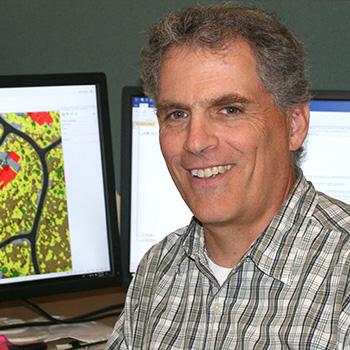81 Carrigan Dr
205E Aiken Center
Burlington, VT 05401
United States
- M.S., Wildlife and Fisheries Biology, University of Vermont, 1998
- B.A., Biology and Environmental Studies, Williams College, 1988
BIO
Sean is a Research Analyst in the Rubenstein School's Spatial Analysis Laboratory, where he plays a lead role in applying geospatial technologies to numerous natural resources and conservation-related projects. He has used Geographic Information System (GIS) and remote sensing applications in wildlife habitat mapping, biodiversity assessment, ecological reserve design, conservation lands, forest characterization, and watershed-scale analyses of pollutant loading.
Most recently, he has used object-based image analysis (OBIA) techniques in conjunction with high-resolution imagery and LiDAR to map natural resources in a variety of urban and suburban settings, including multiple tree canopy assessments (UTC) for cities and counties in the United States. He is currently using LiDAR and OBIA techniques to automate high-resolution mapping of wetlands in heterogeneous landscapes. Sean received his MS in Wildlife and Fisheries Biology from the School in 1998.
Area(s) of expertise
Geographic Information Systems (GIS), remote sensing, wildlife habitat analysis, reserve design, land conservation, historical GIS
Bio
Sean is a Research Analyst in the Rubenstein School's Spatial Analysis Laboratory, where he plays a lead role in applying geospatial technologies to numerous natural resources and conservation-related projects. He has used Geographic Information System (GIS) and remote sensing applications in wildlife habitat mapping, biodiversity assessment, ecological reserve design, conservation lands, forest characterization, and watershed-scale analyses of pollutant loading.
Most recently, he has used object-based image analysis (OBIA) techniques in conjunction with high-resolution imagery and LiDAR to map natural resources in a variety of urban and suburban settings, including multiple tree canopy assessments (UTC) for cities and counties in the United States. He is currently using LiDAR and OBIA techniques to automate high-resolution mapping of wetlands in heterogeneous landscapes. Sean received his MS in Wildlife and Fisheries Biology from the School in 1998.
Areas of Expertise
Geographic Information Systems (GIS), remote sensing, wildlife habitat analysis, reserve design, land conservation, historical GIS
